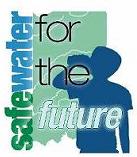
Where Does Contamination Go?
Goals:
Basic goal: To demonstrate conservation of mass, and contaminant movement.
Indiana Proficiencies and Competencies:
Middle/Junior High School 1.1, 3.2, 9.2;
First year Earth and Space Science 1.1,1.5, 6.2, 7.2;
Environmental Science, Advanced 1.1, 1.5, 2.1, 6.1 and 7.1.
Materials needed:
- clear plastic cup
- rice
- food coloring
- water
- plastic soda straw, pipette with bulb, or small turkey baster to use as a simulated well
- small square of gauze
- rubber band
- spray bottle of water
Procedure:
- Prepare the straw, pipette, or turkey baster for use as a pumping well by covering the end with a square of gauze and securing it with the rubber band. Set aside.
- Pour rice into plastic cup, about 1/2 to 3/4 full.
- Add water to a level about 1 cm below the surface of the rice.
- Insert the "well" and pump out some water. (Leave the well in place.)
- Drop a couple of drops of the food coloring onto the surface of the rice and watch what happens.
- Mist the surface of the cup with the spray bottle to simulate rainfall, and observe what happens to the food coloring.
- Pump a little water out from the well again and observe what happens.
- Let the cup sit for about 15 minutes.
- Pump a little water out again and observe what happens.
- Let the cup sit for another 15 minutes.
- Pump a little water out again and observe what happens.
Write down your observations.
Record your observations.
Did the food coloring enter the well? Describe whether it was diluted, and estimate how much dilution, if any has occurred.
Give a hypothesis of what has happened. How could you test this hypothesis?
More Discussion:
- Describe where ground water comes from. In other words, how did it get into the ground in the first place?
- How does contamination get into ground water?
- Can you list some natural and some anthropogenic (man-made) ground water contaminants?
Enhancing the Activity:
Repeat this activity using a deeper plastic cup and vary the depth from the surface of the rice to the water.
Describe why the depth to the water table can affect the risk of contamination to ground water.
Vary the materials in the cup and see what effect other materials have on the migration and/or adsorption of the food coloring. (some suggestions include beans or sand.)
How does this relate to contaminant migration or adsorption in ground water flowing through soils or rocks?
